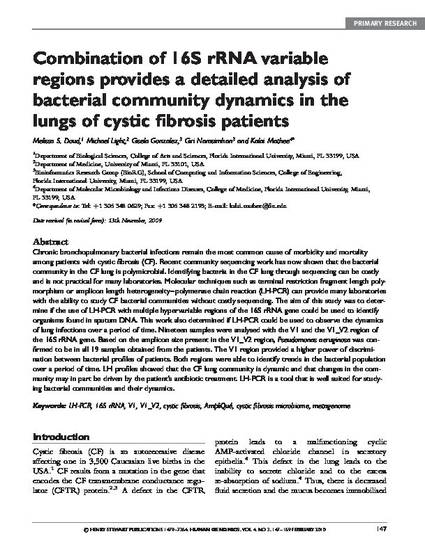
Chronic bronchopulmonary bacterial infections remain the most common cause of morbidity and mortality among patients with cystic fibrosis (CF). Recent community sequencing work has now shown that the bacterial community in the CF lung is polymicrobial. Identifying bacteria in the CF lung through sequencing can be costly and is not practical for many laboratories. Molecular techniques such as terminal restriction fragment length polymorphism or amplicon length heterogeneity-polymerase chain reaction (LH-PCR) can provide many laboratories with the ability to study CF bacterial communities without costly sequencing. The aim of this study was to determine if the use of LH-PCR with multiple hypervariable regions of the 16S rRNA gene could be used to identify organisms found in sputum DNA. This work also determined if LH-PCR could be used to observe the dynamics of lung infections over a period of time. Nineteen samples were analysed with the V1 and the V1_V2 region of the 16S rRNA gene. Based on the amplicon size present in the V1_V2 region, Pseudomonas aeruginosa was confirmed to be in all 19 samples obtained from the patients. The V1 region provided a higher power of discrimination between bacterial profiles of patients. Both regions were able to identify trends in the bacterial population over a period of time. LH profiles showed that the CF lung community is dynamic and that changes in the community may in part be driven by the patient's antibiotic treatment. LH-PCR is a tool that is well suited for studying bacterial communities and their dynamics.
Available at: http://works.bepress.com/kalai_mathee/2/

This article was originally published in Human Genomics
This is an Open Access article which permits unrestricted use, distribution, and reproduction in any medium, provided the original work is properly cited.
© 2010 Henry Stewart Publications